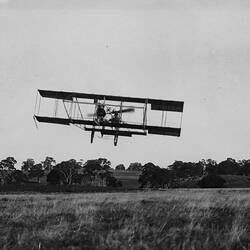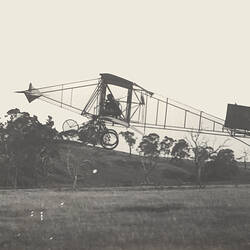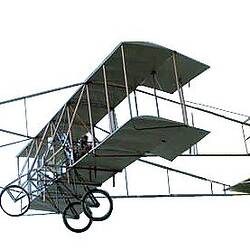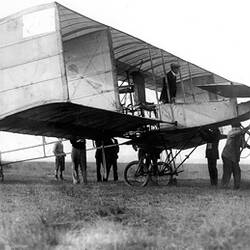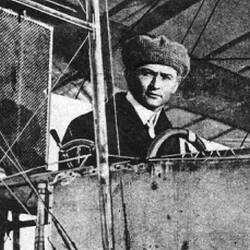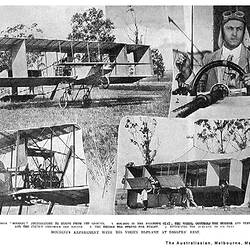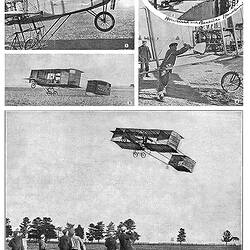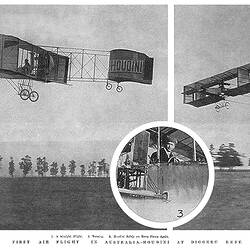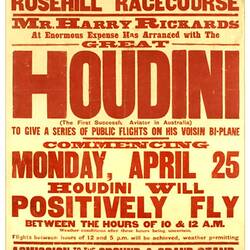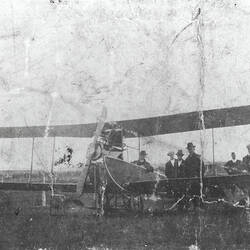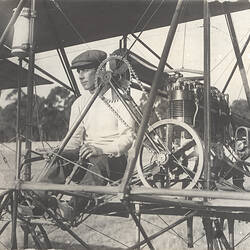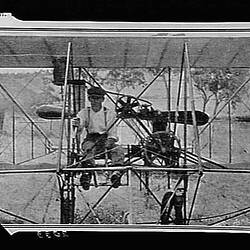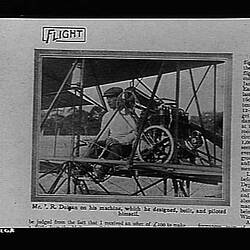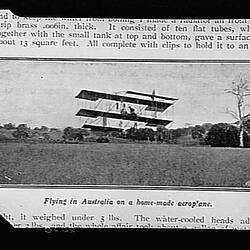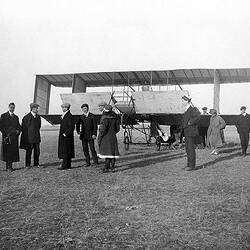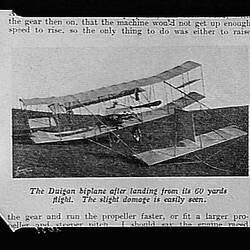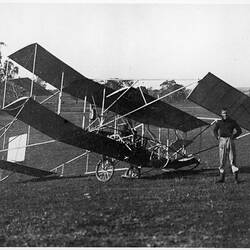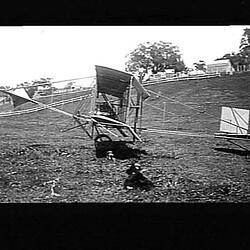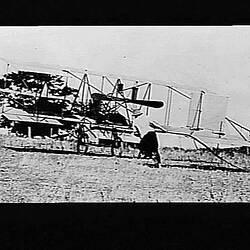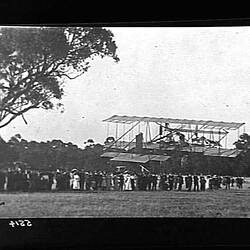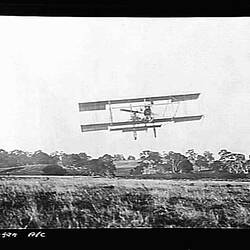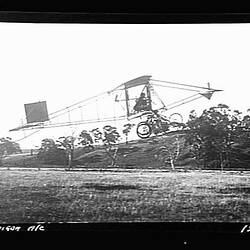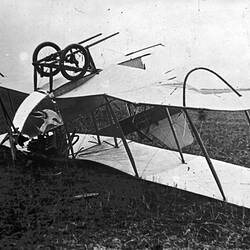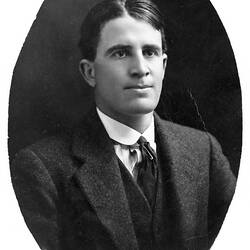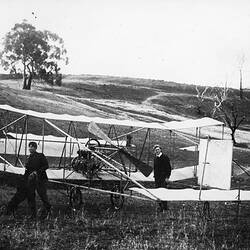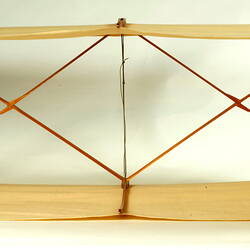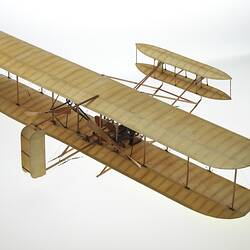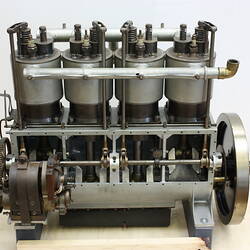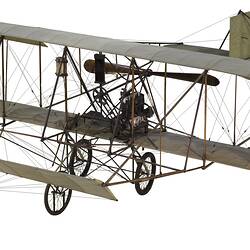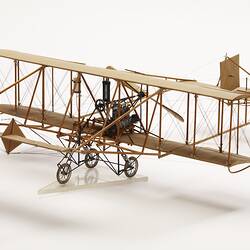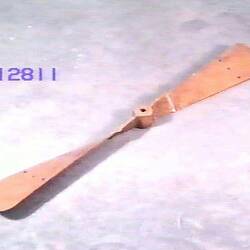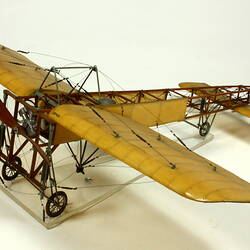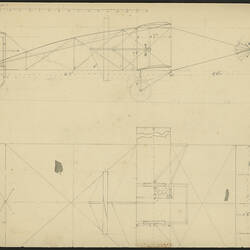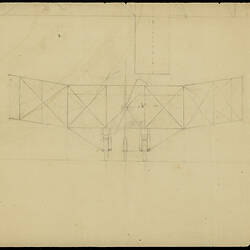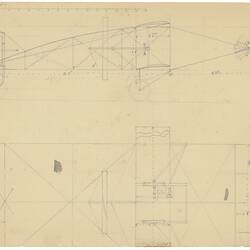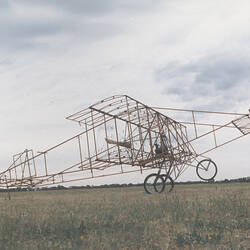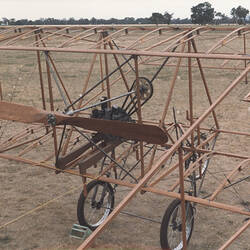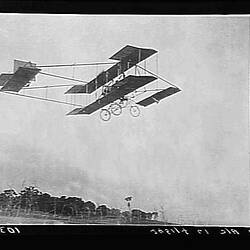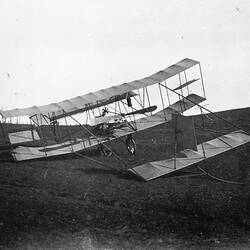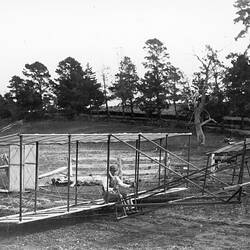On the morning of Saturday 16th July 1910, John Robertson Duigan rose early with a sense of excitement and anticipation. Stepping outside the homestead at 'Spring Plains' things looked promising. The showers and unsettled weather of the past week had finally eased. Though overcast, the cloud was lifting and there was just a faint southerly breeze. Underfoot the ground was still damp and soft, but in all, conditions were almost perfect for flying.
After twelve months of careful construction, testing and adjustment, Duigan had finally completed his own home-built flying machine and was poised on the verge of a landmark achievement.
With the help of his younger brother, Reg, and a station hand, John pulled his biplane out of the shed where it was built and stored and carefully rolled it down the steeply sloping ground to the creek flat below the homestead. There he had selected a long narrow paddock with a slight dog-leg halfway along as the most promising 'flying ground', but to reach it they had to steer the machine through two fences and across a crude plank bridge over Pohlman's Creek.
Once on site final adjustments were made and the engine primed before John Duigan climbed onto the timber board that served as a pilot's seat. Reg started the engine with a couple of short tugs on the propeller and the machine roared into life. As Reg withdrew the wheel chocks, John opened the throttle and the machine lurched forward bouncing gently over the roughly ploughed ground. Gathering speed John took a run up a slight rise and tested the controls finding he could easily maintain course. With growing confidence he then took a run down the hill at greater speed. As he carefully pulled back on the right-hand control lever, the machine made a short 'hop', rising gently into the air and floating freely for about 20 feet before alighting again. A second run resulted in another 'hop' ending with a crumbled tail wheel on landing. At this point John called quits for the day. He was sceptical that the results could be regarded as a true flight and already saw scope for further improvements in the machine, but it was none-the-less a significant milestone in Australian aviation history.
Over the next six months Duigan progressively perfected the machine and his aviator's skills, making some 35 flights over distances of up to quarter of a mile - reaching heights of 60 to 80 feet. On 7 October, before half a dozen spectators, he flew a distance of 196 yards (180 metres) and his success was reported in newspapers across the nation.
His first flight came four months after two imported planes had flown at Diggers Rest and seven months after an earlier flight attempt in Sydney, but he was the first to build and fly a fully Australian aircraft.
From the perspective of the 21st century, it is almost impossible to imagine just how difficult it was to build and fly an aeroplane in Australia a hundred years ago. Working with no first-hand experience of aircraft and only rudimentary information, Duigan repeated the achievement of the Wright Brothers at Kitty Hawk only seven years before. More remarkably his first flight came just four years after the first controlled powered flight in Europe and within two years of the first flight in Britain. The entire enterprise had been achieved with an outlay of just £75 in materials to build the plane and a further £300 for the engine, significantly less than the price charged for planes with little better performance from the first overseas manufacturers.
Milestones of Early Australian Flight:
- 12 Nov 1894 - Lawrence Hargrave is lifted 16 feet (4.87 metres) off the ground by four tethered boxkites at Stanwell Park, New South Wales.
- 5 Dec 1909 - George Taylor makes the first free flight in a glider at Narrabeen Beach, New South Wales.
- 9 Dec 1909 - Englishman Colin Defries makes a brief flight of about 345 feet (105 metres) in a modified Wright biplane at Victoria Park Racecourse, Sydney.
- 1 Mar 1910 - The first attempted powered flight in Victoria by Ralph Conningsby Banks in the same Wright biplane at Digger's Rest, results in a crashed landing after an uncontrolled flight of around 300 yards (274 m).
- 18 Mar 1910 - Hungarian-born American Ehrich Weiss (Harry Houdini) completes the first extended circling flight in a Voisin biplane at Diggers Rest, Victoria. This flight was recognized by the Aerial League of Australia as the first official flight in Australia.
- 16 Jul 1910 - John Duigan makes a short first flight of the first Australian-built aeroplane at Mia Mia, Victoria. Duigan himself considered his later flight of 7 October 1910 to be his first truly controlled flight.
- 1910-1911 - Azor D. Robbins & Aubrey Keith Lock, built a 50 horsepower (37 kW) four-cylinder horizontally-opposed aero engine for a biplane designed by Lawrence Marshall, to compete for a £5,000 Commonwealth Government prize for a military aircraft. The engine failed its intial tests and was rejected by Marshall but was successfully used in a 1913 flight at Albury, New South Wales.
- 20 Feb 1911 - New Zealander Joseph Hammond makes the first cross-country flight in Australia from Altona Bay to Geelong in Victoria in a Bristol Boxkite biplane.
- 3 May 1911 - John Duigan makes the first public flights with an Australian designed and built aircraft before a crowd of spectators at Bendigo's Epsom Racecource, Victoria.
- 5 Dec 1911 - First Australian pilot's licence awarded to William Hart of Sydney, NSW.
References:
Flight, 29 Jan 1910, "First Flight in Australia".
The Argus, 16 Mar 1910, p.13 "Fledgling Aviators Trying Their Wings"; 19 Mar 1910, p.18 "Houdini Flies - Trials At Digger's Rest"; 21 Mar 1910, p.9 "In Full Flight - Houdini's Success - Three And A Half Miles"; 22 Mar 1910, p.8 "The "Bird" Man - Houdini's Latest Success".
The Advertiser (Adelaide), 19 Mar 1910, p.17 "Aerial Flights - Handcuff King's Performance."
Parnell, Neville & Boughton, Trevor, Flypast - A Record of Aviation in Australia Australian Governemnt Publishing Service, Canberra, for the Civil Aviation Authority, 1988
Johnston, Capt E.C., "8. Air Transport in Victoria - One Hundred Years of Engineering in Victoria", Journal of the Institution of Engineers Australia, Oct 1934, pp.377-378.
More Information
-
Keywords
-
Localities
Diggers Rest, Victoria, Australia, Mia Mia, Victoria, Australia, Victoria, Australia
-
Authors
-
Article types

